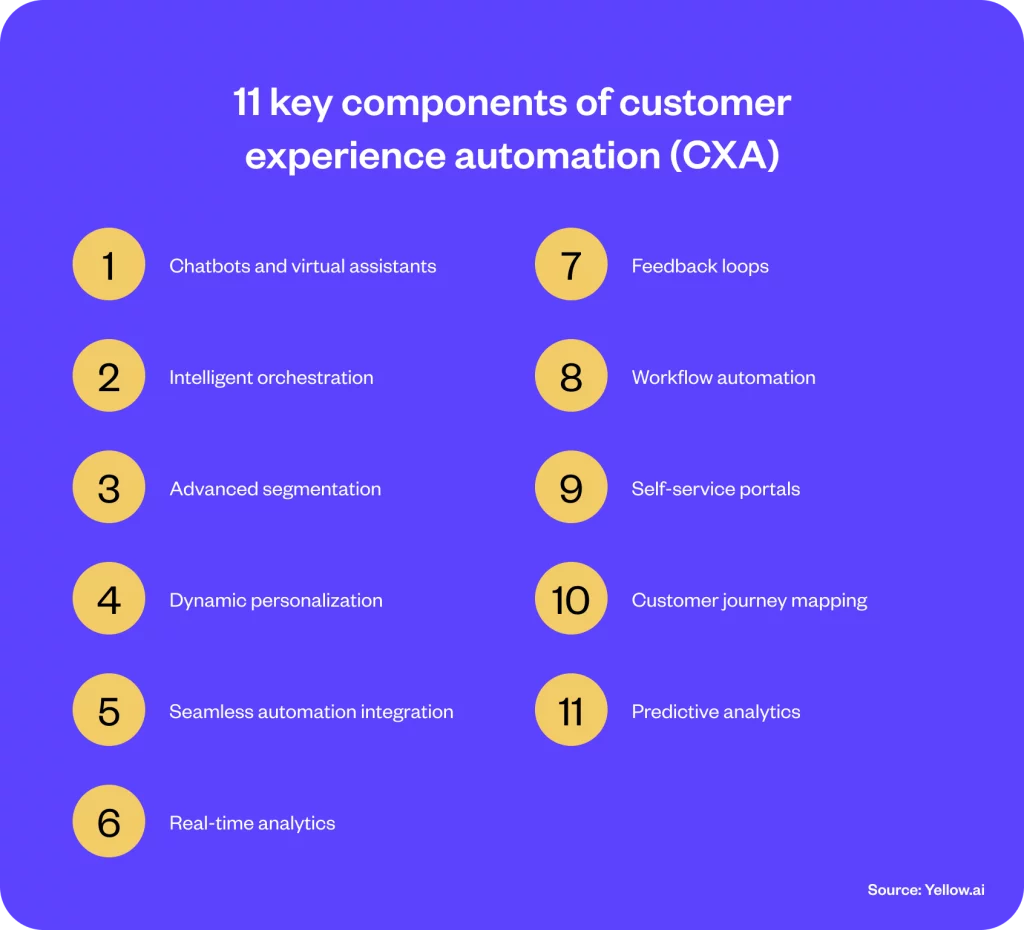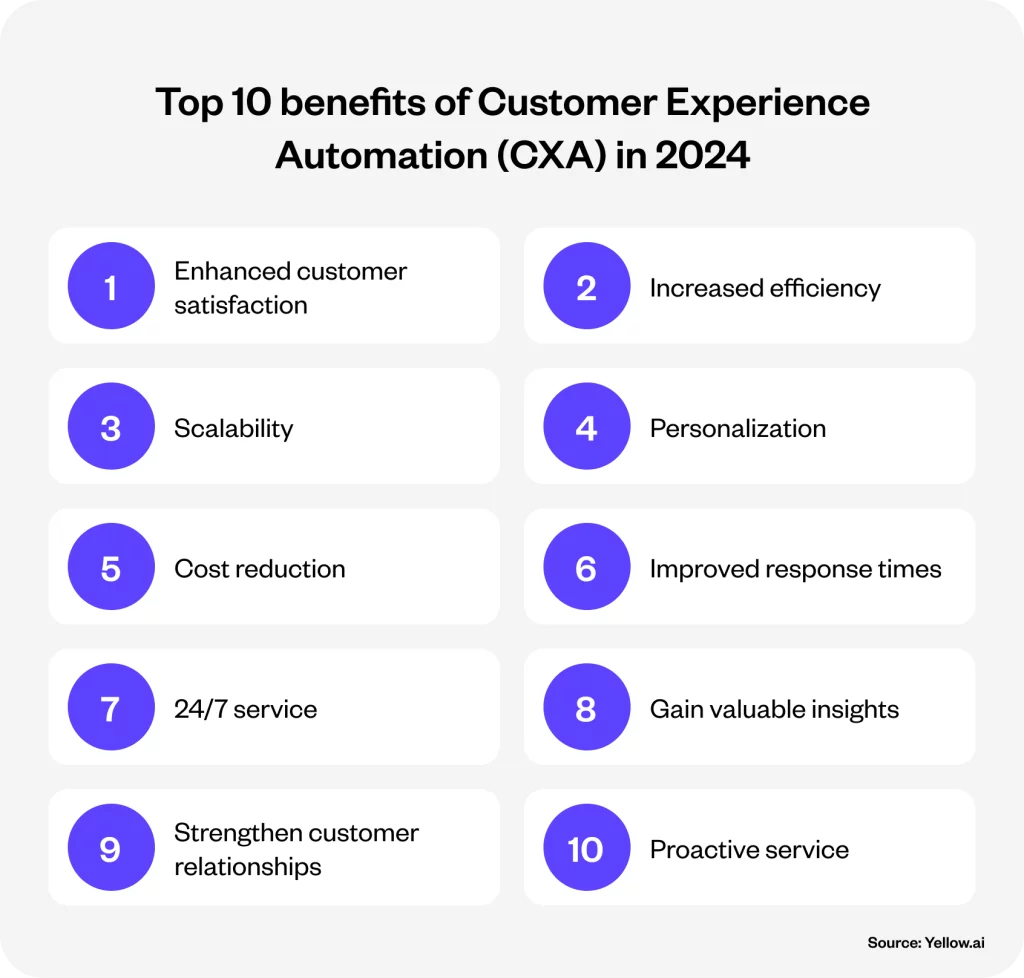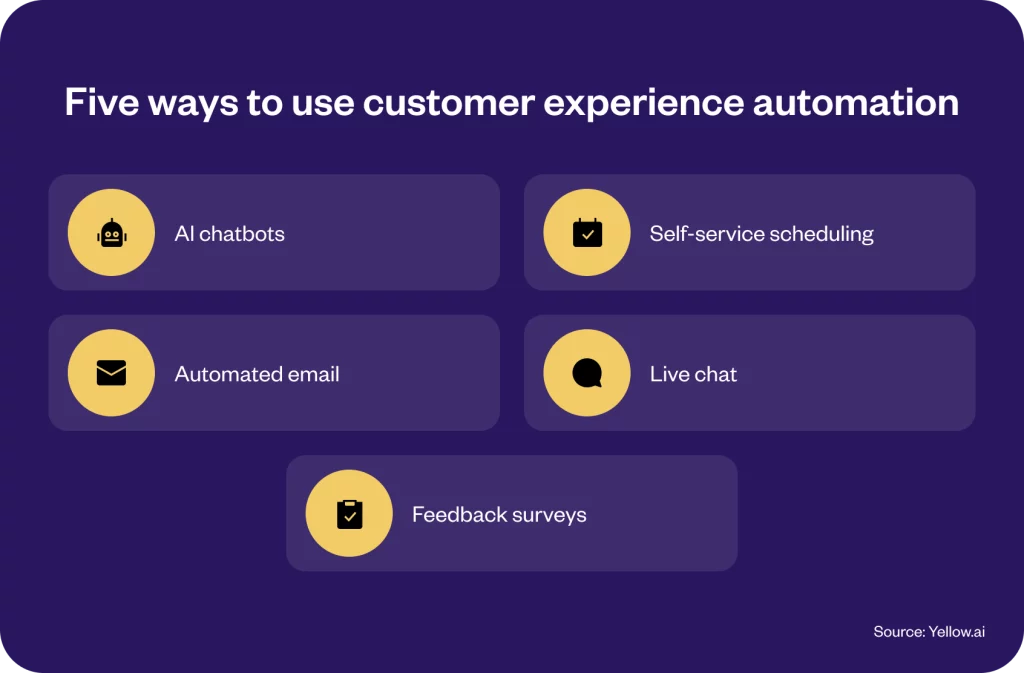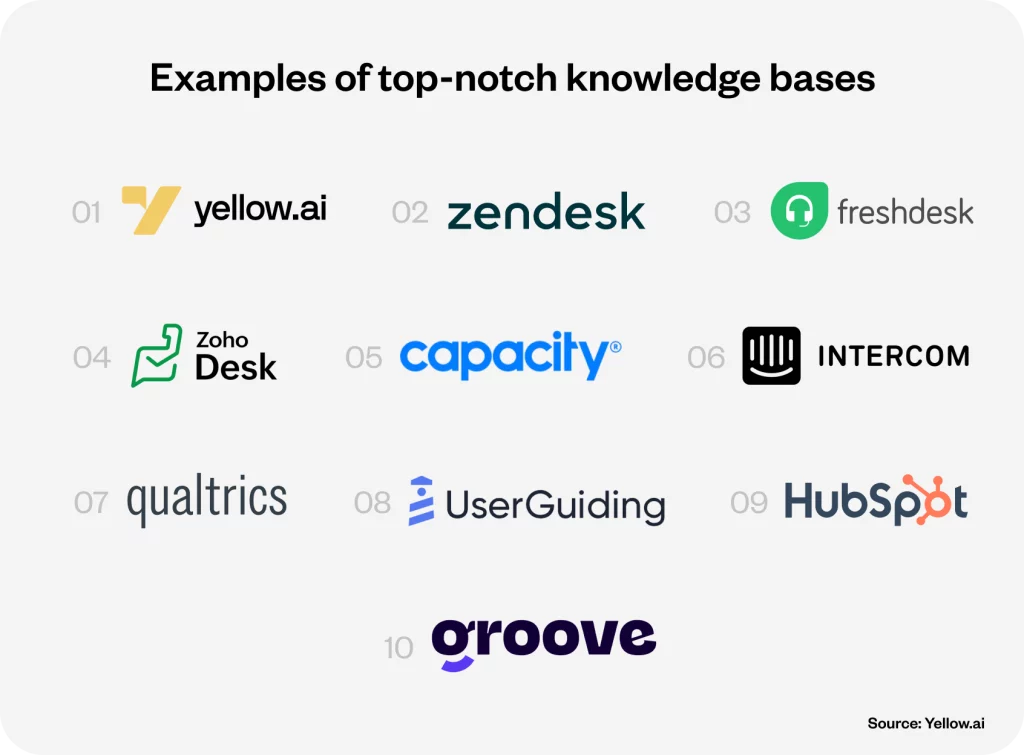Executive summary:
So what is customer experience automation? Customer experience automation, or CXA, is one of the rapidly rising facets of today’s digital customer service industry. For the uninitiated, CXA involves AI technology, AR, VR, and other automation tools to automate customer experience, giving patrons a holistic and fulfilling experience. Using CXA you can understand your customers’ needs better during their journey from start to finish. This enhances communication with existing and future clients, qualifying you to tweak interactions and make them more customized.
The worldwide CX outsourcing market is expected to reach a phenomenal $173.68 billion by the end of 2029. It spotlights the demand for customer experience automation. This blog also contrasts CXA with CRM systems, explaining how they collaborate to optimize the overall customer experience. It also highlights the key benefits of customer experience automation, such as customer satisfaction, increased efficiency, scalability, customization, and cost reductions. Stay tuned until the end, as this blog outlines actionable customer experience automation implementation steps and an overview of the top ten CXA platforms in 2024.
Definition: Customer experience automation (CXA)
Customer experience automation (CXA) is the process of enhancing customer interactions by utilizing automation tools, such as AI agents for chat and voice channels, data analytics, live chats, and automated campaigns through social media and email. It helps in personalized one-to-one and timely communication throughout the customer journey, leading to faster responses and deeper engagement. Since, the major chunk of customer queries and engagement are automated, the human agents can concentrate on high-value customer interactions. 77% of marketing leaders believe automation may improve customer experience, and many organizations can boost satisfaction using CXA. Meanwhile, 32% of customers used VR to test and buy products; 19% utilized VR to purchase luxury goods.
Lead in customer experience automation with Yellow.ai
For instance, you can maximize its benefits by coordinating automation using client information, segregating markets for focused messaging, providing tailored experiences, and empowering such engagements through efficient automated workflow systems. Always remember that customer experience automation goes beyond basic customer service – it involves creating a positive attitude towards the customers and a proactive relationship in any brand touchpoint you may have.
Customer experience automation vs. customer relationship management
It’s easy to think Customer Experience Automation (CXA) is just a more advanced version of the same old Customer Relationship Management (CRM). However, while they both play vital roles in enhancing customer interactions, they serve different and complementary purposes.
CXA focuses on automating the customer journey to ensure efficient and seamless interactions at every touchpoint. This includes tools like AI agents for chat, voice and email channels that provide timely and personalized communication. In contrast, CRM is about organizing and managing detailed customer data and interactions to build deeper relationships and gain valuable insights.
When CXA and CRM work together, the results can be pure customer service magic! CRM systems act as centralized hubs for data, which CXA solutions use to automate specific points along the customer journey, ensuring personalized and consistent interactions across all channels.
Below is a table summarizing five key differences between CXA and CRM:
| Aspect | Customer Service Experience | Customer Relationship Management |
| Primary focus | Automating customer interactions across the entire journey. | Managing and analyzing customer interactions and relationship data |
| Goal | To streamline interactions and enhance the efficiency of touchpoints. | To deepen understanding of customer behaviors and needs. |
| Functionality | Uses algorithms to facilitate immediate and automated customer responses. | Provides tools for tracking, organizing, and accessing customer data. |
| Integration with data | Leverages existing CRM data to optimize interactions at various stages. | Acts as the primary source of data collection and analysis. |
| Impact on customer journey | Ensures a seamless and consistent experience across all channels. | Enhances personalization and targeting of customer engagements. |
| Technology used | AI, machine learning, natural language processing (NLP). | Database management, data analysis, and reporting tools. |
| Customer interaction channels | Social media, messaging channels, chat, email, voice, calls etc. | Primarily data management and reporting, with some customer interaction capabilities. |
| Examples of tools | AI agents for chat, voice and emails, virtual assistants, IVRs etc | Salesforce, HubSpot, Zoho CRM, etc |
11 Key components of customer experience automation (CXA)
There are a few mechanisms which make the CXA process smoother. Here are the 11 key components for the successful implementation of customer experience automation in 2024:

1. AI agents for chat and virtual assistants
Imagine having a dedicated assistant who never sleeps. AI agents and virtual assistants can instantly respond to customer queries, offer personalized suggestions, and resolve problems at any hour. For example, a retail company can use AI agents for chats to help customers track orders and suggest products based on browsing history.
2. Intelligent orchestration
Think of it as a maestro conducting a symphony. Intelligent orchestration leverages customer data to automate crucial interaction points across multiple channels, ensuring timely and relevant communications. For instance, an e-commerce platform can send automated cart abandonment emails to encourage customers to complete their purchases.
3. Advanced segmentation
Picture a party where every guest receives their favorite drink. Advanced segmentation categorizes your audience based on demographics, behaviors, and preferences, allowing for highly tailored interactions. For example, a travel agency might use advanced segmentation to recommend vacation packages based on a customer’s past travel destinations, preferred types of holidays (beach, adventure, cultural), and booking history. This ensures that each customer receives personalized travel suggestions that match their unique interests and needs.
4. Dynamic personalization
It’s like having a personal shopper who knows your style. Personalization engines use AI algorithms to analyze customer behavior and data attributes, delivering customized messages, content, products, and offers. For example, a utilities company can use dynamic personalization to offer tailored energy-saving tips, personalized billing plans, and maintenance reminders based on a customer’s usage patterns, household size, and energy consumption history. This ensures that each customer receives relevant and helpful information that meets their specific needs.
5. Seamless automation integration
Integrate automation tools with existing CRM and analytics systems to ensure a seamless flow of information, enabling instantaneous responses and updates tailored to customer needs.
Did you know Yellow.ai offers 100+ pre-built integrations for faster time to value.
6. Real-time analytics
Real-time analytics monitor and analyze customer interactions as they happen, allowing for quick adjustments and informed decision-making. For instance, customer service leaders can use real-time data to identify emerging trends, such as a sudden increase in inquiries about a particular issue. This allows them to quickly deploy additional resources, update FAQs, and adjust staffing levels to improve response times and overall customer satisfaction.
7. Feedback loops
Consider it like a continuous conversation with your customers. Establishing feedback loops captures and integrates customer insights into operations, allowing for rapid identification of issues and iterative improvements. For example, in customer service automation, AI agents can prompt customers for feedback at the end of interactions. This feedback is then analyzed in real-time to identify common issues or areas for improvement. Customer service leaders can use these insights to refine automated responses, improve conversation flows, resolution times and enhance overall service quality, ensuring that the automated system continually evolves to better meet customer needs.
8. Workflow automation
Imagine having a team of tireless intelligent bots taking care of repetitive tasks with precision and speed. Workflow automation reduces manual intervention, minimizes errors, and accelerates response times, ensuring a smoother operation. For example, in the banking sector, automating the loan application process can significantly enhance efficiency. From initial application submission and document verification to credit checks and approval notifications, each step can be seamlessly automated. This not only speeds up loan approvals, providing customers with faster access to funds, but also improves accuracy and compliance, leading to a superior customer experience.
9. Self-service portals
Imagine a 24/7 library where you can find any book you need. Self-service portals allow customers to find answers, check account details, and complete tasks without human intervention. A utility company might provide a portal for customers to pay bills, report outages, and schedule service appointments.
10. Customer journey mapping
Imagine drawing a detailed map of an intricate journey. Visualizing and analyzing customer touchpoints throughout their journey helps identify pain points and opportunities for enhancement. For instance, an airline can utilize customer journey mapping to streamline the entire travel experience. By examining each step, from booking and check-in to boarding and in-flight services, the airline can pinpoint areas for improvement. This could lead to more efficient check-in processes, personalized in-flight entertainment options, and smoother boarding procedures, ultimately enhancing the overall travel experience for passengers.
11. Predictive analytics
Think of it as having a weather forecast for customer behavior. Predictive analytics use historical data to anticipate customer behaviors and trends, enabling businesses to engage proactively. For example, a retail chain can leverage predictive analytics to optimize inventory management by stocking products that customers are likely to buy based on past purchasing trends. This approach not only reduces stockouts and excess inventory but also ensures that customers find what they need, enhancing their shopping experience and increasing sales. Additionally, predictive analytics can help tailor marketing strategies, offering personalized promotions and recommendations that resonate with individual customer preferences.
10 Benefits of customer experience automation
Employing CXA offers numerous advantages and perks to the businesses, such as enhanced operational efficiency, improved customer communication, and strengthened customer relationships. Listed below are 10 most prominent benefits of customer experience automation.

1. 24/7 service
One significant benefit of customer experience automation is the ability to extend 24/7 service to customers. By integrating automation tools such as AI agents, live chats, and voice AI agents, organizations can provide continuous support, ensuring that current and prospective customers receive immediate assistance regardless of time zones or operational hours. This capability dramatically enhances customer satisfaction by offering timely solutions to common queries that do not require human intervention, even when live agents are offline.
For instance: A cloud services provider implements customer service automation through AI agents to manage incoming service queries and troubleshooting requests 24/7. This automation allows clients from various global markets to receive instant assistance with server configurations or software updates anytime, enhancing operational continuity for businesses reliant on cloud solutions.
2. Cost reduction
Customer experience automation (CXA) offers a substantial cost reduction by streamlining processes and automating routine customer service tasks. This automation minimizes the need for live agent involvement in everyday inquiries, allowing businesses to allocate their human resources more efficiently toward complex issues and strategic initiatives. Companies can reallocate funds to further innovation and growth by reducing labor costs and operational expenses.
For example: A financial services firm employs CXA to automate responses to frequent transaction queries and account balance checks. This shift reduces the workload on customer service teams and lowers the overhead costs associated with staffing, training, and maintaining a larger workforce, resulting in significant annual savings.
3. Enhanced customer satisfaction
Customer experience automation significantly enhances customer satisfaction by streamlining interactions and delivering timely, personalized service. Automated responses and self-service options allow customers to get immediate help, minimizing wait times and improving support quality. According to a Salesforce report, 84% of customers expressed that the experience is important and its significance is equivalent to the products and services a company offers.
For example: An airline can employ CXA to automate check-in reminders and flight status updates via an app or SMS, enabling passengers to manage their travel plans effortlessly. This automation helps resolve common travel concerns swiftly, increasing customer satisfaction.
4. Increase efficiency
Customer experience automation significantly boosts operational efficiency by automating repetitive and time-consuming tasks. This streamlining of processes frees up human resources to prioritize more complex and strategic activities and accelerates response times to customer inquiries. By reducing manual effort and speeding up workflows, businesses can ensure that customers get prompt and accurate services tailored to their needs. According to McKinsey, companies implementing automation in customer service workflows can see up to 40% efficiency gains.
For example: A retail company uses customer experience automation. It might employ CXA to automatically update customers on order status and shipping details, eliminating the need for manual follow-ups by customer service teams.
5. Scalability
CXA enhances scalability, enabling businesses to efficiently manage increasing volumes of customer interactions without proportionately raising operational costs. CXA systems can dynamically adjust to fluctuating demand, allowing enterprises to scale their customer service efforts up or down as needed, seamlessly accommodating growth or seasonal spikes.A considerable 74% of customers want a flawless online experience that matches in-person or phone capabilities.
For example: An e-commerce platform can use CXA to manage the sudden surge in customer inquiries and transactions during peak shopping seasons like Black Friday or Cyber Monday.
6. Personalization
Customer experience automation leverages AI algorithms and data analytics to deliver highly personalized customer interactions at scale. By analyzing customer behavior and preferences, CXA enables businesses to tailor communications, messages and offers to specific consumer segments, enhancing engagement and fostering loyalty. This targeted approach ensures that communications are relevant and resonate deeply with individual customers. According to a report, 52% of consumers expect offers to be personalized—CXA makes this possible on a large scale.
For instance: A streaming service could use CXA to suggest shows and movies on the basis of a user’s viewing history, significantly increasing content engagement and subscription retention rates.
7. Improved response times
CXA has been showing its efficacies in improving response times through the automation of routine tasks and prioritization of inquiries, ensuring continuous and efficient support. By deploying automated systems, businesses can also provide prompt and high-quality support that resolves customer issues more accurately. This reduction in wait times boosts customer satisfaction and strengthens a company’s competitive edge. According to a report by HubSpot, automation can cut response times by up to 40%, leading to higher customer satisfaction rates.
For example: A financial institution utilizing CXA might automatically sort and respond to common inquiries about account balances or transaction statuses. This cuts down unnecessary wait time for a human agent to be available for a basic query.
8. Obtain valuable insights
A Salesforce report says 76% of consumers expect enterprises to understand their needs and expectations. Customer experience automation generates vast amounts of data from client interactions and behaviors, offering a treasure trove of insights. Businesses can uncover deep understandings of customer preferences, dissatisfaction areas, and emerging trends by analyzing these data points. This strategic analysis enables organizations to make informed decisions, optimizing customer experiences to meet evolving needs and expectations.
For example: A retail clothing brand using CXA can analyze customer feedback to enhance its product offerings or improve its return process.
9. Strengthen customer relationships
CXA bolsters client satisfaction and loyalty and facilitates stronger, more sustainable customer relationships through tailored, seamless interactions at every touchpoint. By automating communications and keeping the brand consistently top-of-mind, CXA ensures each customer interaction is personalized and impressive, increasing the likelihood of repeat business and customer advocacy. According to Accenture, companies focusing on enhanced customer experiences can witness a 3-7% boost in revenue.
For example: A B2B tech firm can employ CXA to schedule regular check-ins and feedback sessions with clients using automated scheduling tools. This personalizes the experience and demonstrates ongoing commitment to client success, enhancing client trust and loyalty.
Pelago reimagines customer experience with Yellow.ai’s Gen-AI powered automation

10. Proactive Service
CXA enables businesses to understand and resolve potential customer issues before they escalate proactively. By utilizing advanced analytics to analyze historical interactions and behavioral data, CXA helps identify patterns and preemptively address challenges. This proactive approach betters the overall customer experience, boosts satisfaction and builds customer loyalty by preventing issues from arising.
For example: An online jewelry brand might use CXA to identify common customer complaints before major sales events, allowing them to address these issues in advance.
Five ways to use customer experience automation
There are several ways to use customer experience automation efficiently and get the desired result. In today’s modern digital customer service businesses are witnessing the inclusion of AI, especially Generative-AI. Apart from this, there is also an extensive utilization of machine learning or ML.

Here are five ways to leverage CXA and gain a competitive edge:
1. AI agents for chat
AI agents excel at enhancing automated CXA. By integrating advanced technologies such as sentiment analysis and human-like regional language interaction, these AI agents are transforming customer experience automation. They offer prompt responses to frequent queries, saving customers the frustration of prolonged waits for live human agents.
2. Self-service scheduling
Customers can effortlessly schedule appointments through self-service tools. They are guided through the booking process via intuitive question-and-answer interfaces. Once scheduled, automated confirmations provide reassurance, ensuring a smooth, hassle-free experience.
3. Automated email
CXA helps in email automation types to facilitate customer interactions:
- Abandoned cart: Gently remind customers about items left in their virtual shopping carts, potentially retrieving lost sales. Include customized product suggestions to boost engagement.
- New subscriber: Warmly greet new newsletter subscribers, offering an engaging introduction to your brand’s essence.
- Transactional: Communicate in a timely manner by sending order confirmations, instructions for resetting passwords, and information regarding account updates.
4. Live chat
Customers require prompt responses beyond typical business hours. Live chat is another element of customer experience automation that addresses this need, offering immediate solutions. Furthermore, it streamlines routine tasks for customer service teams, boosting their productivity and enabling them to focus on complex inquiries effectively.
5. Feedback surveys
Gauging customer satisfaction is crucial. Automated feedback surveys provide invaluable insights into how well expectations are met. They gather responses on recent interactions, shopping experiences, and overall satisfaction. Analyzing this data will highlight areas for improvement, aligning an organization’s services with its customer preferences.
How Yellow.ai’s customer experience automation helps businesses to master CXA
Yellow.ai is one of the most preferred platforms, offering several CX innovations, including customer experience automation. With its industry’s first-of-its-kind Gen-AI, YellowG, this leading platform transforms how businesses engage and interact with their customers. With its pioneering AI-driven tools, technologies, products and solutions such as chat AI agents, voice AI agents, live chat, and email automation, it has empowered leading brands from across the world to provide personalized, 24/7, friction-free and human-like empathy to make their customers valued and thus leading to a fulfilling experience.
Here are a few key features of Yellow.ai that help implement and succeed in customer experience automation (CXA) in 20224.
1. Blending AI with human empathy
At Yellow.ai, customer experience automation isn’t about harnessing Artificial Intelligence. It understands that customers’ experience and satisfaction require human empathy. And it blends both to take advantage of automation without losing the human touch.
Cut operation cost by 60% with Gen-AI
2. Sentiment analysis
At Yellow.ai, the AI agents are trained in human sentiment analysis. Thus, responses, queries, or complaints are addressed by understanding the customers’ emotions.
3. Personalized interaction across omnichannel
With Yellow.ai customer experience automation, customers receive personalized responses based on their data across channels. They can connect with a brand on their preferred platform, which can be a call, web chat, email, Whatsapp, or social media, by exploring Yellow.ai’s omnichannel presence over 35 channels. This ensures a unified and coherent customer experience, increasing satisfaction and loyalty.
4. 80% prompt response with Email Automation
Yellow.ai’s latest feature, LLM-powered Email Automation, is the industry’s first. It allows businesses to automate 80% of responses to inbound customer emails. This feature is trained to analyze the customer’s intent, track many nuances of the customer journey, and strategically respond to emails.
Watch the video to understand how Yellow.ai Email automation improves customer experience!
5. Tailored products and service suggestions as a proactive approach
Yellow.ai customer experience automation is a smart one. Now, brands can give their customers a holistic experience through individualized product and service suggestions, reminders of subscriptions, promotional offers, loyalty rewards, etc., through personalized email, social media and message campaigns.
6. Being available 24/7
By partnering with Yellow.ai, the business provides round-the-clock customer service with our AI agents. They enhance customer experience. Yellow.ai’s Dynamic Automation Platform (DAP) helps to deliver 24/7 responses, handling 80% of customer queries and engaging with its multilingual prowess. It cuts down customer churn by delivering better FRT and thus boosting sales conversions.
7. Advanced data analytics and insights
Acquire comprehensive insights into how customers behave and what they want, allowing for data-driven decisions to improve the customer experience. Exploit data from consumer interactions with AI-powered insights, allowing you to create custom-made experiences at scale. AI-driven analytics and insights like these also help agents perform better by constantly improving strategy.

Summing up customer experience automation
As we are almost halfway through 2024, we can witness the adoption of customer experience automation by businesses across the industries worldwide. By looking at the success, positive impact and benefits of CXA, several new players are shifting gears to embrace it. From meeting and exceeding customer expectations, improving customer satisfaction, and enhancing engagement and brand loyalty, the perks of automating customer experience are many. A favorable consumer experience enables organizations to construct and fortify their brand.
Customer experience automation, or CXA, makes processes smoother, tailors interactions, and addresses customers’ needs on time. This drives satisfaction, productivity, and business growth. If you want to scale up your customer service to provide a better experience, augment efficiency, be available 24/7, provide proactive service, and increase revenue by retaining customers and acquiring new ones, CXA is the answer. Select the right CXA tools by considering factors like the complexity of support needs, desired channels, scalability, etc.
Reimagine your business with Yellow.ai’s customer experience automation

Frequently asked questions (FAQs)
How does automation improve customer service?
Automated customer service allows you to provide swift, 24-hour help. In contrast to human agents, AI agents operate continuously, ensuring that consumers can obtain responses to their inquiries at any time. Besides answering queries, automated customer support tools may proactively engage consumers.
What is automation in customer experience?
Customer experience automation, or CXA, is the use of an AI-powered platform designed to automate, scale, and eliminate friction from interactions between a company and its customers, from the start of the conversation to its completion.
How does automation impact customer satisfaction?
Automation can have many positive impacts on customers. The benefits include higher efficiency through faster response times, increased customer satisfaction with prompt and accurate assistance, and a more personalized customer experience.
Can automation help in gathering customer feedback?
AI and automation can substantially enhance customer feedback methods by giving real-time, precise, and actionable data. AI-powered sentiment analysis can sift through massive amounts of consumer feedback data, discovering patterns, attitudes, and particular concerns in real-time.
How does automation handle complex customer queries?
Customer service and experience automation address challenging queries by first attempting to grasp the client’s problem using natural language processing techniques, which let the system interpret and classify the customer’s input.
What is the future of customer experience?
Customer experience automation has a bright future. Research predicts that by 2030, smart machines will conduct 67% of brand-consumer digital engagements. Customer engagements will involve 69% automated judgments.




















